Sinclair ZX Spectrum is a whopping 35 years old on 23rd April 2017. That’s only 15 years away from half a century. So, although I’ve covered this glorious system in a previous triple part documentary, that was about 2 years ago, and frankly it deserves better. So here we are, at the beginning of the ZX Spectrum Story.
Of course you can’t tell the ZX Spectrum story without Sir Clive Sinclair, so we begin near Richmond, Surrey on the 30th July 1940 as Clive was born to Thora Marles and George William Sinclair, known as Bill. Bill Sinclair was at the time a mechanical engineer who ran his own machine tool business in London assisting with the Ministry of Supply. It makes sense then, that Clive would follow suit in a similar field. Spending his younger years in the relative safety of Devon at the height of London’s bombing, Clive spent his younger years enjoying swimming and boating but also developed an unquenchable interest in learning. The Sinclair’s were a frank speaking family and this open honesty led Clive to peruse topics he found interesting whilst negating anything he concluded was superfluous.
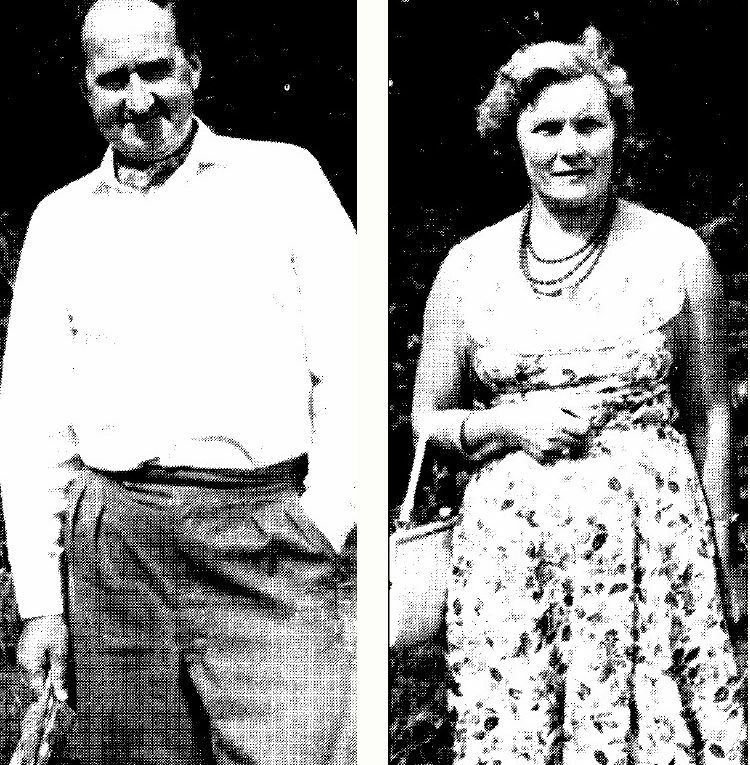
This drive led the young Clive into mathematics where at high school, he developed a calculating system driven by punched cards. The system he built worked around a binary system conjured for it’s simplicity. This was without even realising that this was a system already widely used, particularly in the developing area of computing.
As the 1950s pressed on Clive stumbled across the exciting world of electronics and began a hobby of building electronic circuits, whilst engaging in entrepreneurial endeavors on the side. Initially this included manual work, but as his self taught electronic knowledge grew, moved across to holiday jobs at electronic companies, one of which was called Solatron; a company which persists to this day, but at the time developed a range of scientific devices including X-ray spectrometers and oscilloscopes. It was through this work that Clive found himself writing his first article for Practical Wireless magazine before he’d even left school, but even then Clive knew his future lay in establishing his own business.
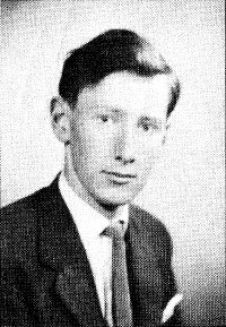
Upon leaving school in 1957, Clive already knew the University route was not for him. Why waste time learning unnecessary information through education when he could continue researching and teaching himself exactly what he needed to know? A route that would allow him to keenly follow the cutting edge of electronics, without the bloat of University.
Clive had already began drawing up ideas and required money to turn them into sell-able products. To finance these products, Clive’s first port of call was Practical Wireless magazine, where he continued to write freelance articles and for a brief period was reportedly hired by the magazine as an editorial assistant. It seems Illness with the editorial team meant Clive took on a larger role at the magazine than was initially predicted, whether official or not, gaining a greater understanding of advertising in the business whilst conversing frequently with the magazine’s editor; Frederick James Camm. This helped solidify a reputation for himself whilst fulfilling his creative needs by printing various circuits in various issues.
But Clive wanted more… His next offer came from Bernard Babani, owner of Bernard’s publishing who wanted Clive to write books for hobbyist engineers. At twice his salary of £1,000, Clive jumped aboard and found himself completing “Practical Transistor Receivers Book 1” in January 1959, followed by “Practical Stereo Handbook” and a range of other titles, with his last being “22 Tested Ciruits using Micro-alloy Transistors” in 1963.
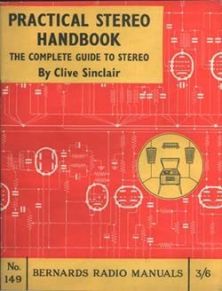
The book writing ended because in 1961 Clive had registered Sinclair Radionics Ltd. with the idea of creating and selling micro hi-fi kits, but the backer for his plan pulled out at the last minute, leaving Clive in limbo. As with these things however, it was forunate, as his next job at United Trade Press for Instrument Practice magazine would create the foundations for the business to take off. One of the companies he spoke to in his role, Semiconductor Ltd had a reject rate of 70% on their new micro-alloy transistors, but Sinclair found these rejects were perfectly usable if a circuit could be designed to accommodate their loose characteristics. Upon producing a design for a micro amplifier he negotiated to buy these rejected transistors for 6d each in boxes of 10,000 and sell his adapted products at a marked profit. By this point it was already evident that Sinclair’s genius lay in his ability to minaturise designs into cost effective, elegant, solutions.
Now, we could spend all day going over the inventions and steps which took Sinclair from here to the almighty ZX Spectrum, but already it’s clear that Sinclair’s path, although on a different road, is already heading the same way as another low cost Hi-Fi entrepreneur from this era, Alan Sugar. Each of these paths would meander out on very different routes, whilst occasionally meeting at a cross roads to get to our reach our anticipated goal… and as I’ve already covered these things in other videos let’s cover this next period in a brief but yet concise, manner.
Sinclair’s first office was at Gough Square, London although packaging and assembly was handled by Cambridge Consultants Ltd at 69 Histon Road, Cambridge. Wishing to stand out from the other tightly packed adverts he’d grown to know through hobby magazines, such as Practical Wireless, Clive began placing large, well spaced out, half page blocks, promoting his new, tiny kits. These adverts, he continually refreshed so as to continually grab the eye of readers, whilst other companies churned out the same layouts, again and again and again. This also enabled Clive to stay ahead of the rather hands-off advertising standards, as by the time anything amiss has been pointed out, a new advert was already running.
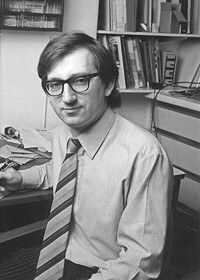
In 1963, Jim Westwood who had been working at Bernard Barbani’s shop, and thus, knew well of Clive, applied to Sinclair for a position. Clive immediately hired him and the duo began testing transistors from the small London office. Sales picked up at a rapid pace and by September ’63, Nigel Kember was brought aboard as Sinclair brought out the Micro-injector; a square wave signal generator, and by April 1964, the operation had moved to Anchor House in Islington and the well known Sinclair logo was firmly established, emblazoned across the company’s first newsletter for publishers, vendors and of course, the enthusiasts. It was from this new premesis that the new tiny Micro 6 transistor radio set was pushed, gaining wide attention and praise, both by the press and customers alike, enough so that Sinclair would move yet again to accommodate new staff and new facilities. The chosen location was Comberton – just outside Cambridge.
It’s from here, where Sinclair really moved into the world of budget amplifiers, starting with the X-10 and really culminating in 1972 with the System 3000 and 4000 which attempted to break into the conventional hi-fi market at around the same time as our friend, Alan Sugar. But this period also marked a number of other significant hires into the business. Lyndsey Lloyd and Chris Curry joined in 1966, with Chris quickly becoming a right hand man to Sinclair, the two often found barnying in the office and then later having a whale of a time in the near-by Plough. By 1970 Sinclair Radionics again required larger offices, and it found it at The old Mill, in St. Ives. During their time here, the building underwent massive refurbishment to bring the image in line with Clive’s expectations, including a sliding door on Clive’s corner office, which if shut, you knew was completely off limits.
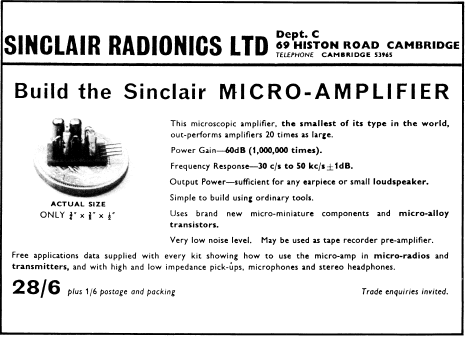
It’s this period where Sinclair really gained the reputation of delays that would persist into the 1980s. As well as ever increasing advert sizes, including for the Project 80 ultra modern non-obtrusive hi-fi, Sinclair was diverging into alternative products such as the DM1 digital multi-meter. This, like most of Sinclair’s products, beat competitor pricing, whilst at the same time providing a much more compact solution that what was available. However production problems meant delays, and with high order numbers in the bag, adverts began appearing apologising to customers for product delays.
It was Sinclair’s next product however which really solidified the company as a revolutionary enterprise, and moved the company in a new direction.
Calculators weren’t new products. They had been on the scene since the mid 60’s, as chunky desktop units imported from the USA and Japan, but Clive spied a new challenge. After vising Texas Instruments, he picked up a new TI GLS 1802 chip which he handed to Chris Curry and Jim Westwood to turn into a pocket sized calculator. David Park designed a circuit which pulsed the power on and off, allowing the unit to be powered by hearing aid batteries and in September 1972, the Sinclair Executive was launched, taking the world by storm and winnning several awards including the Design Council award of ’73. The components for the unit cost just £10, but it sold at £80. This was truly elegance and minaturisataion at it’s finest and the recent introduction of decimal currency to the UK in February 1971 meant the timing could scarcely have been better. Over the subsequent years, new calculator innovations came about leading to The Cambridge and Executive Memory models, each one taking a step closer to a programmable computer. To cope with demand, Sinclair began outsourcing manufacture, but this led to reliability issues, somewhat tarnishing the brand.

The company’s turnover in 1972 was at £762,000. By 1974, thanks to the calculators this was at £4,090,000. Sinclair was at this point investing tens of thousands into research and so maintaining this healthy income was essential.
One of these lines of research had led to the Black Watch. Released in 1976, production problems meant it was 2 years later than expected, and plagued with reliability issues. The chips had been tested in the damp winter months, but in the dry summer, the design was rather sensitive to static, causing the timepiece to freeze. Not ideal in a watch. Coupled with this, the battery performance was terrible, and there was issues with overheating and even explosions. Faulty products meant, lots of returns, lots of replacements and a long period where the company wasn’t actually making any income. In April ’76, Sinclair’s accounts showed a loss of £335,000, so Sinclair, keen to keep research going went to the recently formed, National Enterprise Board for assistance. The NEB agreed to buy a 43% stake for £650,000, as the calculator sales at the time were strong.
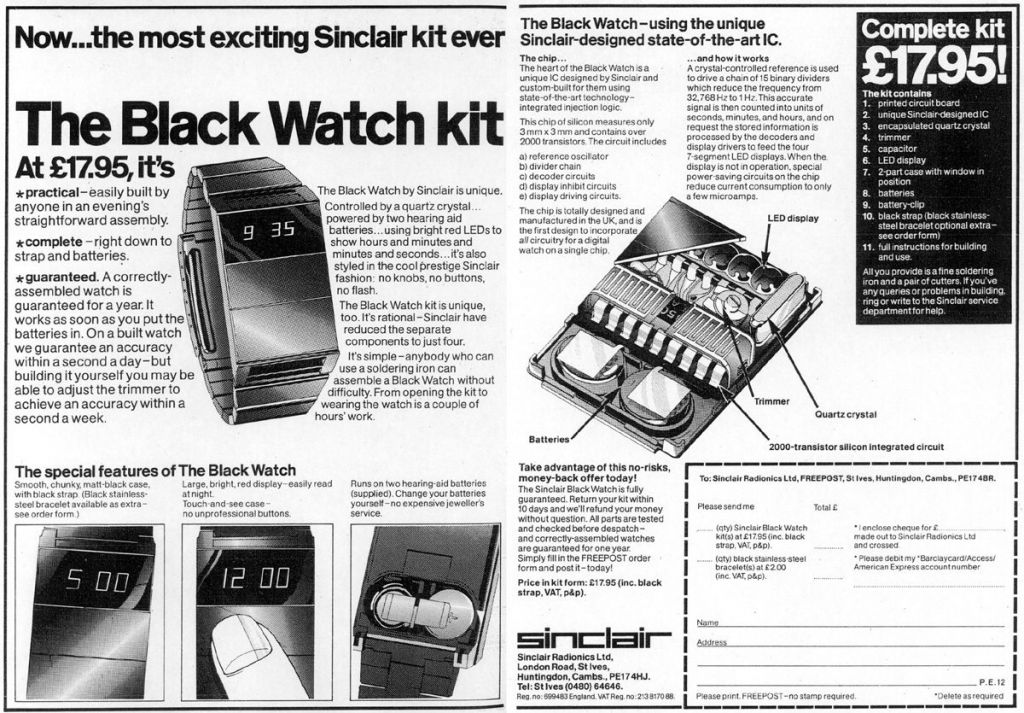
Back in ’63 Sinclair had begun work on a portable television named the Microvision. At the time, the technology wasn’t quite up to speed for launch, but Sinclair had continued to develop the technology and by 1977, thanks to NED assistance, the TV1A was introduced. However in that time, calculator sales had fallen and the NED had increased their holding to 73%, meaning Sinclair wasn’t exclusively in charge any more.
A possible solution to save the company was the development of a Sinclair micro-computer, which Clive began work on, however the economics meant that the product needed to sell 20,000 in order to become profitable and the NEB were nervous about further investments. Another company under the NEB’s wing snapped up the design and this would later be released as the Newbury Newbrain. By March ’79, the NEB had decided that it could no longer finance the Sinclair Radionics operation. The TV was sold to Binatone and the NEB retained the instrument division which later became Thandar Electronics ltd and Clive was left with a golden handshake of £10,000 and visions of the future.
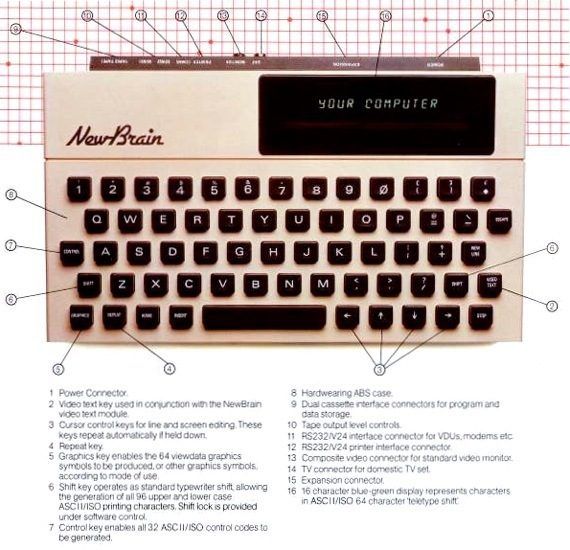
But where would these visions come from?… Cunningly before the NEB arrived, Clive had appointed Chris Curry to begin running a side company called Science of Cambridge at 6 King’s Parade, named so, as the intention was to find and sell local ideas. Borrowing £500 from his father to pay the first month’s rent, Curry set to work, and with the help of John Pemberton launched the wrist calculator which was an instant success, creating a revenue of £50,000.
Curry’s next product then fell into his lap courtesy of Ian Williamson. Williamson had been an electronics engineer at Cambridge Consultants and using Sinclair calculators had managed to develop a programmable micro-processor system, which he ran by Clive for further funding. Clive passed the idea to Curry and a deal was drawn up. However supply issues with the components Williamson used meant that National Semiconductor were able to complete an equivalent design for much cheaper and therefore won the contract. Sinclair would later pay Williamson for documentation for the device as a gesture of thanks, but the Microprocessor Kit 14, as it would be known would likely not have been created without his initial design.
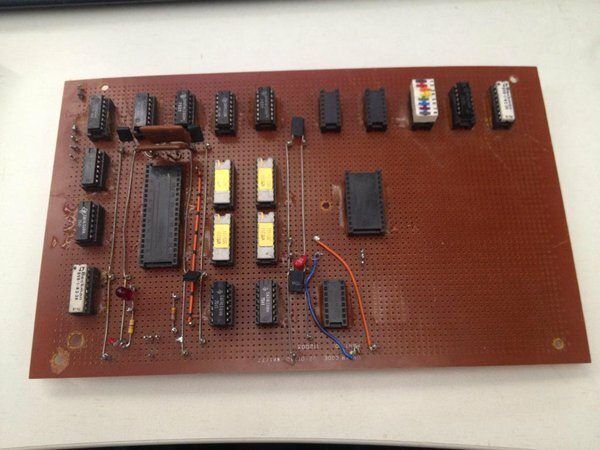
At first, Clive saw little potential in the unsightly looking machine, but going on sale for £40, it sold 10,000 units in just a few weeks. This was what actually inspired Clive to attempt a micro-computer under the NEB at Sinclair Radionics. But that had now been, gone and Clive was now himself at Science of Cambridge… albeit, without Chris Curry.
Although Curry had laid the foundations for the new venture, his time in charge paved his path. He knew he now wanted to run his own company, and a fortunate meeting with Hermann Hauser at Cambridge University whilst seeking ideas had led to him setting up Acorn Computers in mid 1979 at Market Hill. The first Clive knew about this was seeing an advert for the Acorn System 75 – essentially an MK-14, with a proper keyboard, and bringing direct competition from his most trusted colleague to his doorstep.
With some of his previous staff now under the new office roof, others remained at the former Radionics Mill, but were contracted out to Clive and his new venture. It was clear in Clive’s mind was the next step should be, and that step would come in the guise of the Sinclair ZX80. An “almost” fully fledged micro computer, that retained the membrane keyboard of the MK-14, but which could be hooked up to a television. It seems Clive’s obsession with television would finally come to pass, albeit, in a different way to his original intentions.

In May 1979 the Financial Times had written “Personal computer will become steadily cheaper and their price could drop to around £100 within five years”. Clive had taken on this challenge and beaten it, sensationally, with the ZX80 launching in January 1980 for just £99.95 fully assembled, or £79 in kit form. The low price had been met by radical ideas, mainly from Jim Westwood. Using a domestic TV was an innovative step in the world of computers at the time, and the Z80A microprocessor supplied by Nippon Electric, carried out nearly all the work, alongside the large custom ROM, with a BASIC interpreter written by John Grant of Nine Tiles. Specification wise, it was extremely basic and sported only 1KB of RAM as standard. To mark this now clear direction, Science of Cambridge would be renamed to Sinclair Computers Ltd in 1980.
Clive was aware of not repeating his past mistakes, and taking on more than he could chew. To this end he was becoming more proficient in delegation and had recruited Nigel Searle, who had been working as a consultant for Sinclair over in Boston during the calculator years to setup a North American office to sell the new units by mail order in the States. He also outsourced manufacture of the units to Tek Electronics in St. Ives, followed by Timex in Dundee when the orders really started flooding in. Quality control on this occasion meant the return rate was only 1%.
The machine sold reasonably well in the US market. Coupled with the UK success, this allowed Clive to continue research on another idea he’d played with at Radionics… a flat screen TV, which also meant a final name change to Sinclair Research Ltd; a name that would represent the company’s intention of creating new, innovative, elegant products and revive the Sinclair name to it’s former lofty heights… The success also allowed Jim Westwood to continue work on the ZX80’s follow up, the ZX81, which had begun before the 80 was even released.
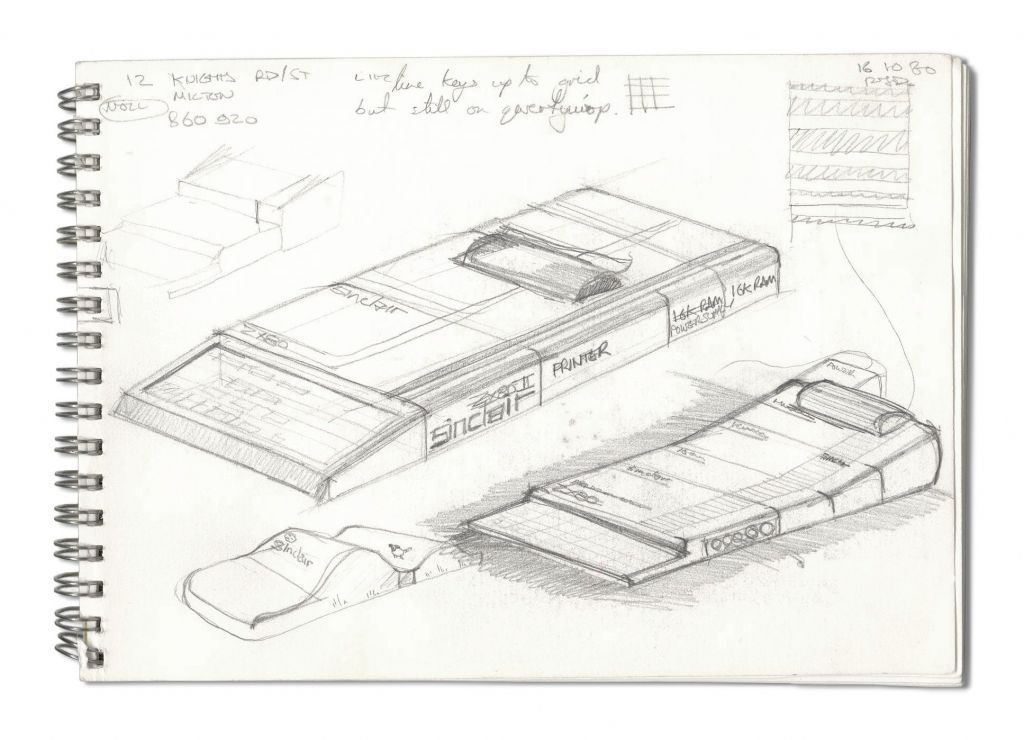
The ZX81 would address the main issues with the ZX80. The first of which was the lack of floating point arithmetic in the ROM, and the second was the flickering of the screen whenever a key (or membrane) was depressed. The first was addressed by doubling the size of the ROM and adding an array of useful routines and features. The second was corrected by implementing a slow mode, so that when a key was pressed, the entire run time of the Z80 wasn’t used in re-drawing the screen. Instead it was shared with code execution, meaning everything ran at a quarter speed, but it looked much more pleasing to the eye.
The design of the ZX81 was also much neater and cost effective. Whilst the ZX80 consisted of 18 discreet chips, the 81, condensed them into 1. This single chip was a custom Uncommitted Logic Array; a logic chip which incorporated many of the ZX80’s components into one array. Much of this chip’s design was completed by Jim Westwood and Richard Altwasser, and as well as reducing cost, it also vastly reduced heat output, meaning the 81 was a much more stable design.
With Christmas 1980 on the horizon, rumours were beginning to emerge that the BBC was looking to produce a television series aimed at teaching the BASICS – if you’ll excuse the pun – of computer programming. It was also rumoured that they were perusing Newbury’s Newbrain to be the machine featured on the show; Sinclair’s old design which had been sold off under the NEB. By this point both Sinclair and Acorn had computers on the market, in Acorn’s case this was the Atom, and both Curry and Sinclair were a little outraged that other manufacturers hadn’t been considered. With pressure from both sides, the BBC re-thought its strategy and put out a tender for various manufacturers to submit proposals. Clive immediately touted the new ZX81 machine as a candidate, with it’s advanced Sinclair BASIC and accessories that would include a printer. Perfect for educational use. He also tried to sell the merits of an up and coming model, named the ZX82 or Sinclair 9200 at this point, that may have included a built in flat screen and micro floppy drives… A idea which was maybe a little ahead of itself. However the BBC was concerned about the membrane keyboard on existing models, and weren’t prepared to wait for this next Sinclair model. Chris Curry on the other hand was prepared to bend over backwards to meet the BBC’s time scale and requirements, and having visited the BBC himself decided to go with a prototype Acorn had mocked up based on their planned Proton computer.

In spite of this setback, the ZX81 arrived in March 1981 and by the end of January 1982, some 300,000 machines had been sold worldwide. Agreements had been made to sell ZX81’s in WH Smith’s, moving Sinclair out of the mail order game and directly into the high street. Sinclair also decided to fight back at the BBC’s government backed computer scheme by offering a half price deal to place ZX81’s in schools, complete with printer, and undercutting any BBC Micro package Acorn were offering. Although Acorn clearly had the edge in the educational market, Sinclair still notched up sales to 2,300 schools through this promotion.
By mid 1982, Timex were granted rights to licence current and future Sinclair machines in America for a 5% royalty, which freed up Nigel Searle to head back to the UK and head up the growing computer operation in the UK. As well as Sinclair expanding it’s production and research labs, the ZX81 also sparked a large number of cottage industries and third party software developers, including a users club, magazines, programming books and of course a wide variety of games.
Sinclair had setup the UK, and other parts of the world, whether intended or not, for a computing revolution. Now all that was needed was the right computer to grab this revolution by the horns and run with it.
The ZX82
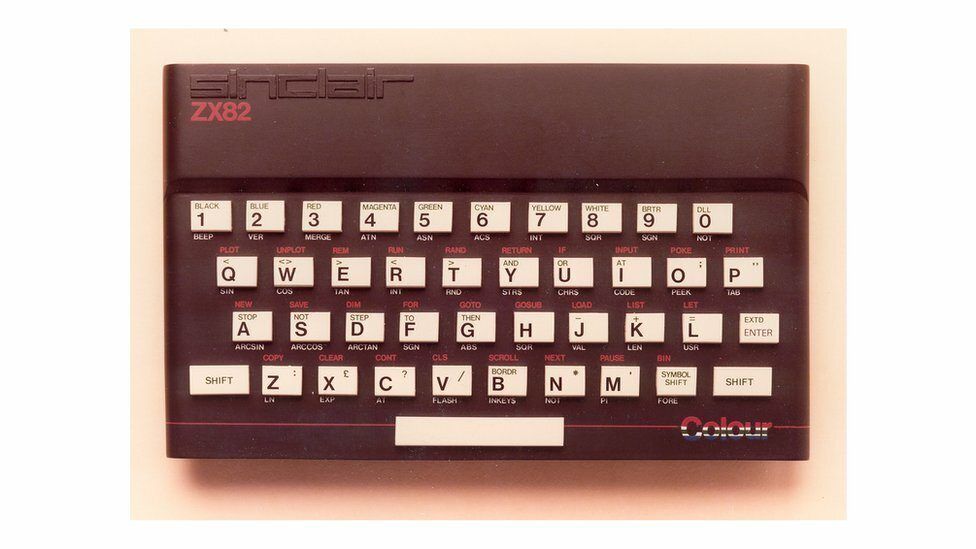
The ZX82 development was no secret. It was obvious that Sinclair would be working on a new machine, to keep up with the BBC Micro if nothing else. 50,000 ZX80’s had been sold and over 300,000 ZX81’s, and so the specifications for the next computer were laid out;
At it’s heart would remain a Z80A CPU clocked at 3.5MHz. This seemed obvious as it allowed some of the existing ROM to be ported over but remained a potent CPU. Developed by Zilog, it’s actually the successor to the Intel 8080, developed by Zilog’s founder Federico Faggin and incorporates 16 bit I/O addressing, on chip dynamic memory refresh control and very simple power requirements.
The ROM would be expanded from the ZX81’s 8Kb to 16Kb, written by John Grant and Steven Vickers, and allowing for a more comprehensive Sinclair BASIC
16Kb of Dynamic RAM would be standard, allowing an upgrade to 48Kb for enthusiasts.
A resolution of 256×192 would be available through a colour video generator offering 8 colours, and 2 shades of each, apart from the black, which was just…. black. Like most computers of this era, the machine has a 56 line border (in PAL regions), whose colour can be changed but can’t be populated with graphics under normal use.
The design also purposely incorporated the familiar “attribute clash”. This was a patented method which forced a 2 colour per character cell restriction. Some viewed this restriction as unfavourable outside of character mode, but having the colour information at a lower resolution saves precious memory allowing for much more complicated games than would otherwise be the case. It also brought out the creative genius of developers, with the best using clever graphic sizing to eliminate the clash entirely.
The keyboard would now offer moving elements and an on board speaker would provide rudimentary sound.
Port wise, it remains pretty basic with an expansion edge connector, tape input and output, 9V DC and RF output.
In fact, the ZX82’s specifications were in part Clive’s response to the BBC’s requirements for a computer system, and even in light of losing the contract, still made perfect sense, offering a true upgrade to the earlier ZX machines.
Of course, to make the ZX82 affordable and elegant, like Sinclair’s previous machines, the ULA would become an even more essential component and an even more intricate design, using twice the number of gates.
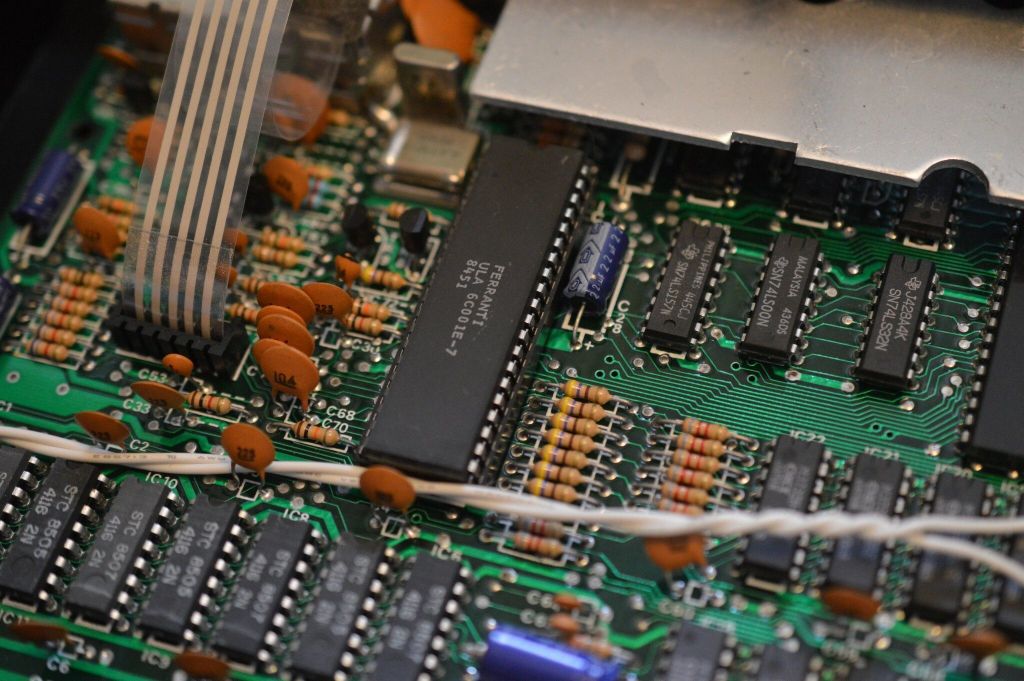
For the ZX82 this ULA performs the role of video generator, clock generator, memory access governor, keyboard controller, cassette I/O and speaker driver. It also co-ordinates CPU access to each of these resources ensuring that the television output is never disrupted. Richard Altwasser was in charge of this ULA as Jim Westwood moved back into Sinclair’s television development and manufacture was again handed across to Ferranti’s Current Mode Logic.
Interestingly, Ferranti actually made an error in one of the interconnect layers of the chip, failing to connect some of the stages. But incredibly, a rogue piece of dust happened to fall at the exact spot this connection was supposed to be, creating an artificial bridge which enabled Altwasser to funny test the ULA one one test die. Confirming that the 5C102E design was good to do.
This compact design allowed Rick Dickinson to get to work on another elegant case design with guidance from Clive Sinclair, and with this the iconic rainbow effect was added, alongside a new name for the machine that would convey it’s improvements over the earlier machines.
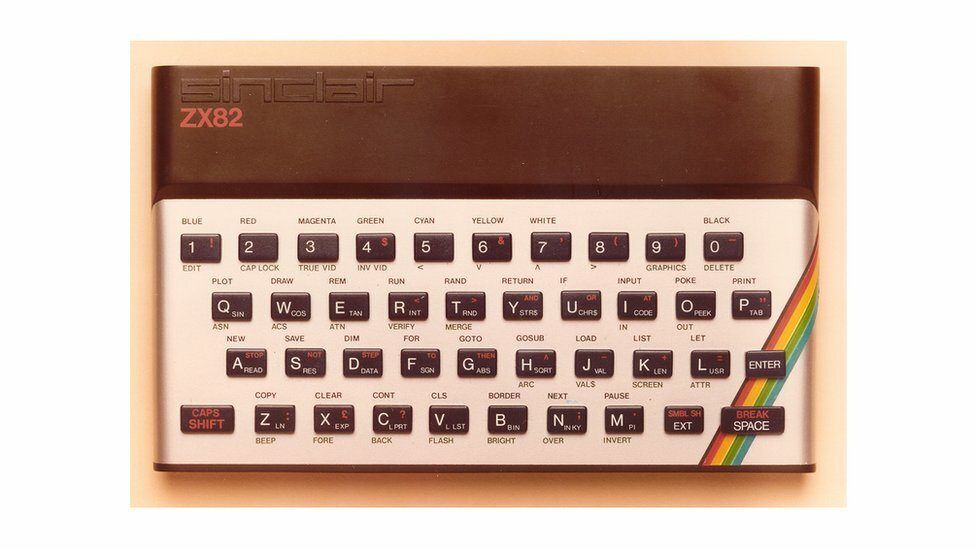
The ZX Spectrum was launched on 23rd April 1982. The ZX was retained as a nod to the Z80 processor, whilst also sounding futuristic. Spectrum, of course referred to the new Spectrum of colours availablee. Initially, both 16KB and 48KB versions were available through mail order for £125 and £175 respectively and production was set for 20,000 a month. Like his earlier hi-fi devices, Clive’s outlook to advertising hadn’t changed. Large, expansive adverts, packed with text and specifications drew in enthusiasts and boggled consumers enough to be tantalised. Clive expected to sell some 300,000 units in the first year and the machine was very competitively priced compared to say the BBC Micro, which retailed at a pocket shrinking £399.
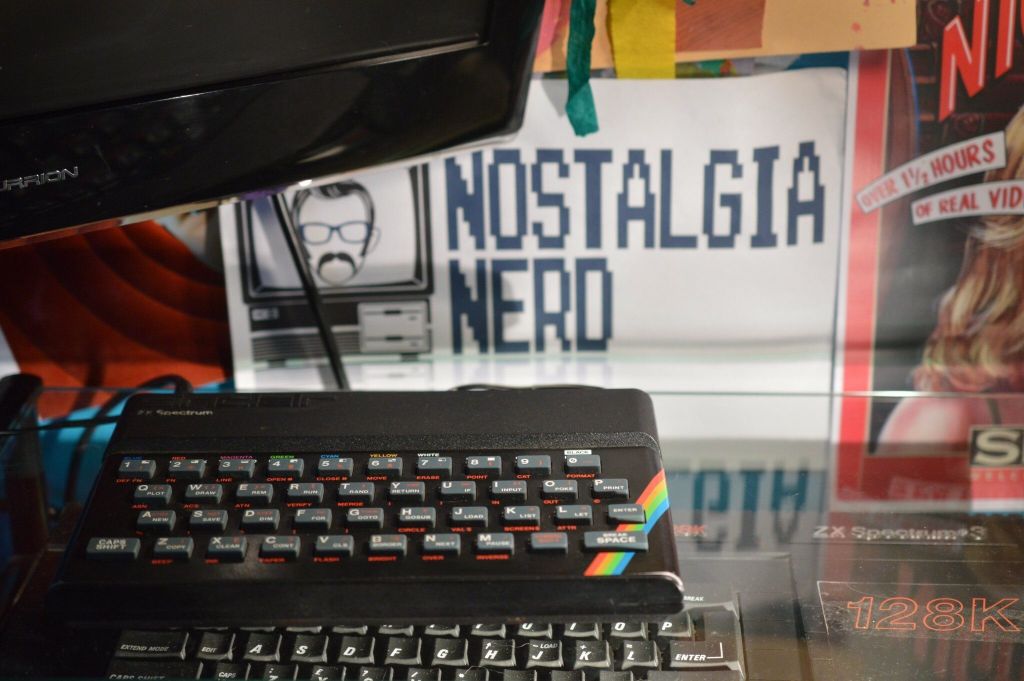
Initial reception of the machine was fairly positive, although some, like Jim Lennox of Technology Week noted;
“After using it… I find Sinclair’s claim that it is the most powerful computer under £500 unsustainable. Compared to more powerful machines, it is slow, its colour graphics are disappointing, its BASIC limited and its keyboard confusing”
In part this was due to the space saving nature of the keyboard, where the space bar resided on the right and BASIC commands were accessed via keywords, allowing them to only use up 1 byte of memory, compared to several bytes when entered in a traditional character by character approach. The BBC Micro had been launched in December 1981, however production was only ramping up to acceptable levels after rushed launch. The Spectrum was set to make inroads, but like the Micro, early production numbers were somewhat limited and customers had to wait sometimes months to obtain their units, in a typical Sinclair style.
There were also some known issues with the original Sinclair power supplies. It was declared that “up to 14,000” of them could cause electric shocks, a figure later updated to 28,000 by Your Computer magazine. The fault was down to the 240V input track on the power pack’s circuit board running far too close to the 6V output, meaning that a power spike in very humid weather could result in a shock. Nigel Searle admitted that the supplies, which were limited to one batch, “were not checked in detail for safety”. Amazingly Sinclair managed to turn around replacement units in 48 hours. Which given their track record for delivery was mind-blowing.
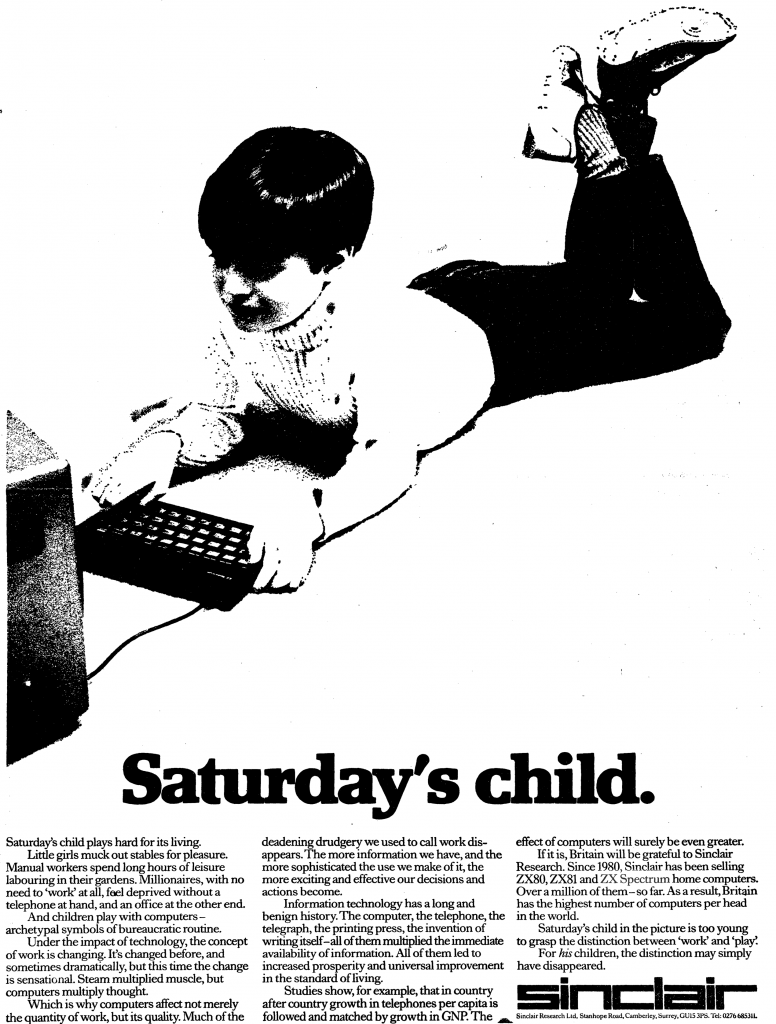
As 1982 pushed on, the Department of Trade and Industry were setting up a second promotion of microcomputers in primary schools after the success of BBC’s Computer Programme earlier in the year and orders for the Spectrum began arriving, causing Sinclair to begin work on their own educational software alongside Macmillan publishing, including the fabled Learn to Read Series and Horizon programs.
Of course, educational software aside, games were already piling up for Sinclair’s new machine. It’s low price, sound and colour graphics suited this domain perfectly and companies like Ultimate Play the Game run by the Stamper brothers were setup to capitalise on this growing industry.
By February 1983, distribution of the Spectrum was widespread. As well as W.H. Smiths; Boots, Curry’s and John Menzies were able to stock systems through Sinclair’s main distributor, Prism Micros. 200,000 Spectrums had already been sold by mail-order, mainly 48KB models, and now 15,000 units were being sold per week in the UK alone, excluding the other 30 countries where the system had also launched, albeit on a much smaller scale. Owners of 16KB models could also upgrade their models through a daughter board on first edition machines, or RAM chip replacements on second revisions. These upgrades cost £60 and proved fairly popular as most games made use of the full, expansive 48KB of memory. There were of course classics such as Jetpac and Transam which would run under 16KB, but 48K was a no brainer.
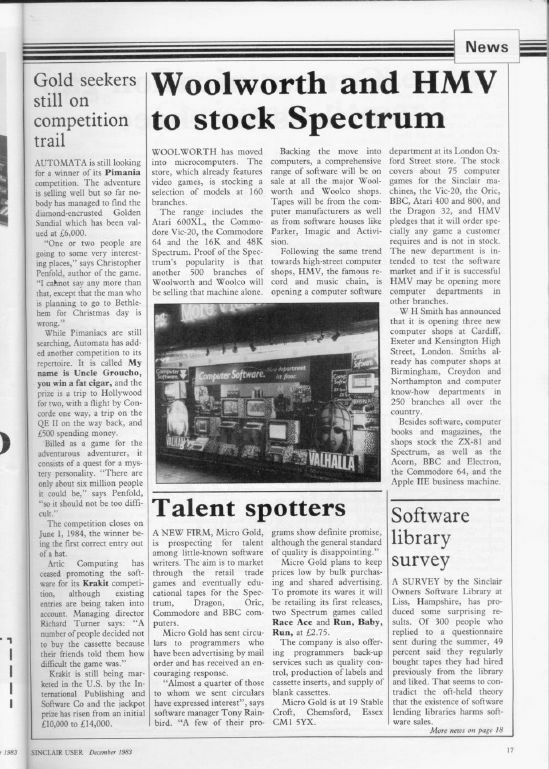
Economies of scale enabled Sinclair to lower prices to £99.95 for 16K and £129.95 for 48K models by April, further causing upset for Acorn Computers, who were watching the low end games market grow before their eyes. The arrival of the Commodore 64 on UK shores at around the same time, initially at £399 and quickly reduced to £299 did nothing to ease the minds of Chris Curry or Herman Hauser. The american machines sold well, but did little to dent the budget market Sinclair were dominating.
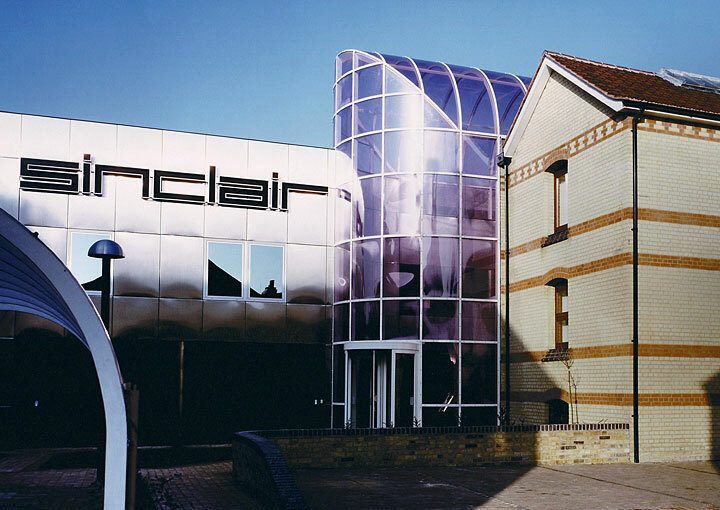
This rapid expansion meant that once again, Sinclair was on the move, and this time the destination was the previous Barker and Wadsworth spa water bottling plant at 25 Willis Road, Cambridge, which won an environmental award in January 1984 for the internal design, including an enclosed atrium and a conversion of the existing mineral well into an integrated environmental control system. As usual with Sinclair, the company image was as important as the products they were shipping.
January 1984…. For some of us this year might set alarm bells ringing. By now Acorn had become so fed up watching the gaming market slip past that they had launched their own budget system, the Acorn Electron. However, production problems meant they’d missed the critical 1983 Christmas period and had a large stock pile of systems now unsold. For Sinclair, nothing seemed amiss as 1984 began. By the end of 1983, 1 million Spectrum’s were sold – celebrated by Timex producing a white cased version, their sole UK distributor, GSI had opened a new warehouse and there was more software than you could shake a stick at. Their turnover for the 1983-84 financial year was £77.7M, with pre tax profits of £14.3M. Very similar profits to their previous year, albeit on a turnover of only £54.5M for that period. The reason for this discrepancy was in part due to the continued research Sinclair had been putting into various products, including their next computer, code-named the ZX83 and the flat screen TV80 which launched in September 1983 and cost at least £4M to develop. The Sinclair C5, electric car; A project which had been on Clive’s mind since the late 1960s, was also ongoing, but Clive has siphoned this off into a separate company; Sinclair Vehicle Ltd which he funded through a private share issue of Sinclair Research, netting him almost £13M for just under 10% of his company. A figure which therefore placed the company value at well over £100M.
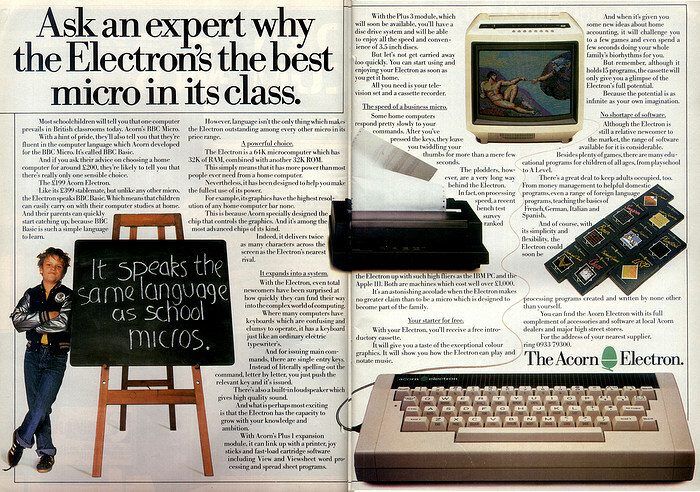
The video game crash of 1983 felt in the United States, wasn’t really felt over here, safe as we were in our bubble of home-bred micro computers. But a ripple of it was starting to come into force and in many ways the itching’s of our own crash were beginning to be noticed. At the start of 1984, the home micro market was swamped with manufacturers from every corner of the UK. Dragon, Newbrain, Camputers, Sinclair, Acorn and foreign companies like Commodore were also making an impact. At the same time, demand for these micros was rapidly being met; every person who bought a machine meant one less buyer in the market. Of course new models and innovations were designed to encourage upgrade, but Sinclair’s next model just didn’t fill that gap effectively.
Unlike Acorn, who had decided to downgrade their system and plunge directly into the Spectrum’s rapidly filling play-field. Sinclair were still improving their technology, but rather than providing an upgrade for existing Spectrum owners, their next machine was designed to meet a different market. A more serious market.
The brief was simple. A machine designed for a specific gap in the now educated market – the business user about to embark on computing. Thought to be a market some 10 times the size of home computing and currently dominated by systems costing over £2,000. July 1983 had seen the Microdrive expansion launched for the Spectrum. A tape cartridge, spliced from video tape and looped, allowing the tape to be advanced and read incredibly quick, allowing for access times similar to floppy disk at a lower cost. The Spectrum’s perhipheral also added an RS232 interface and was launched at the same time as the ZX Interface 2, allowing ROM cartidge compatibility.
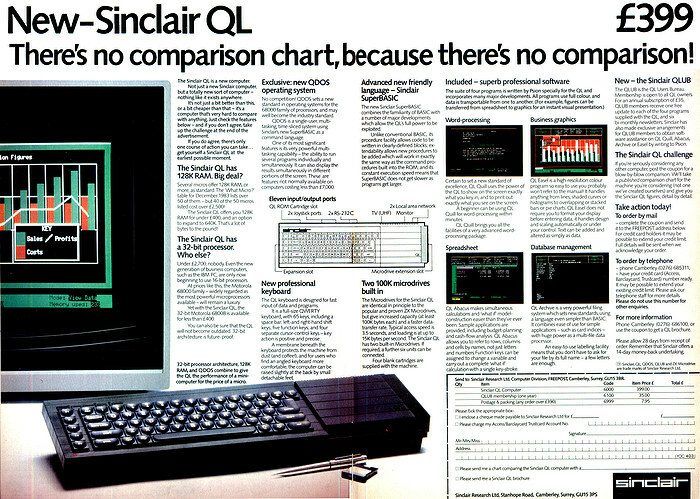
For the ZX83, these microdrives, allowed a cheap way to get business like disk speeds without dipping into expensive floppy disk systems. Named the QL, or Quantum Leap, this computer was announced for launch in January 1984, but was somewhat intentionally incompatible with ZX Spectrum software, and particularly, games. Clive thought that games damaged the credibility for a machine, not grasping that most people were already using the Spectrum for both business and pleasure tasks. Perhaps with the kids playing games in the day, and business activities accomplished in the evening.
Still, the launch at the Inter-Continental Hotel was suitably grand and certainly grabbed press attention with bulk delivery expected for February 1984. By May, sinclair had taken £5M of orders for 13,000 of the £399 machines, but there was still no sign of the product. Nigel Searle’s method was to fix a date and make engineers work to it, therefore eliminating procrastination. However, in this case, the launch date was set much too early and finalised machines didn’t limp out until September – some 7 months later than expected. The machines which limped out before then were essentially prototypes, some requiring an additional EPROM to be plugged into the cartridge port on the back.
The QL was unlikely to be a winner from the off, with these issues, it became less and less likely. 60,000 machines were sold in the first year – far less than hoped, with total sales only reaching 100,000.
The Spectrum continued into 1984, as other micros were either falling or experiencing difficulty. The QL may have failed to realise its goals, but its design did inspire a new look for the faithful Speccy. By July Sinclair announced a £4M Christmas advertising campaign and centre of this campaign was the new Spectrum+… cunningly making use of the QL keyboard design to address critics of the Spectrum’s rubber, toy-like keyboard.
With the +. The Spectrum was finally looking like a professional system that could sit next to the Commodore 64, BBC Micro and Acorn Electron. Not to say the original design was bad. It wasn’t. But many didn’t associate the design with a “proper computer”. Something our friend Alan Sugar, had already latched onto with the introduction of the Amstrad CPC just a month prior. It could easily be stated that the + was a direct response to the CPC, but it was also a logical next step for a company that had spent the last year neglecting to work on a suitable follow up for the popular micro.
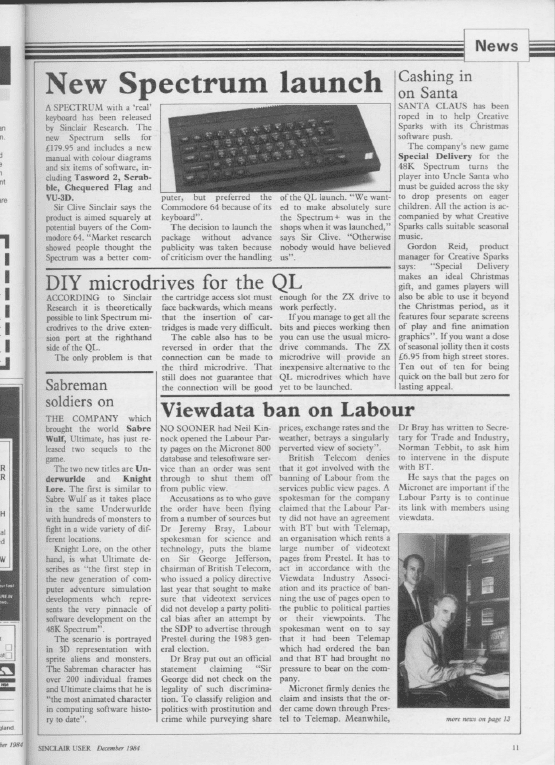
Unlike the QL, The Spectrum+ wasn’t delayed, launching at £179.95, including a bundle of 6 applications “worth over £50″…. again a little reminiscent of the 12 titles, “worth over £100”, bundled with Amstrad’s CPC package. Existing Spectrum owners could even upgrade to a + case for £50, or £30 through a DIY kit. Other than the case design and reset switch which simply shorted pin 26 on the CPU, the design was exactly the same under the hood, however, a failure rate of up to 30% was reported. Significantly higher than the 6% seen before. Whether this was due to board design changes or customers simply returning their systems as they’d expected the revision to hold more powerful hardware under the hood – perhaps becoming confused with similarities with the QL – is somewhat unknown.
As Christmas ’84 loomed and with the 2 millionth Spectrum produced, Sinclair was predicting record sales, whilst Acorn was still hoping to shift their back-stock prepared for the Christmas before. Acorn had also begun cutting the price of the BBC Micro and bundling a tape recorder with software in a bid to hold onto what they perceived to be a shrinking market in the face of increasing competition. This was also the Christmas of the infamous – and somewhat blown out of proportion – punch up between Clive and Chris Curry as tensions rose in Shades, a Cambridge wine bar which was bustling with both Acorn and Sinclair staff, having moved on from the Baron of Beef pub portrayed in the BBC Dramatisation, Micro Men. As Chris tells it, Clive snuck up behind him and put his hands around his face, making Chris see red and land a light blow, but was instigated by an advertisement Acorn had run highlighting the reliability of Acorn machines, compared to the Spectrum.
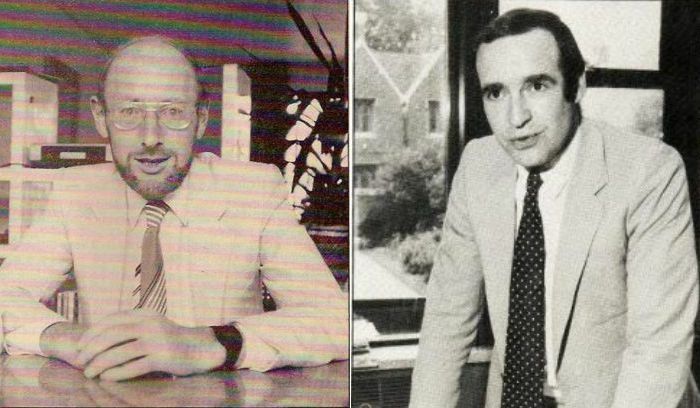
From Clive’s perspective, these figures were simply down to the fact that Sinclair offered an essentially unlimited window for return;
“Many of our customers are in the 14-15 year old age bracket. These are characters who can destroy granite with one blow of their fist, so a computer gets a pretty tough pounding over the course of the year, and they’ve been entitled to return that machine and swap it over the counter for a fresh one at ANY time during the year. So yes, we get a lot back, but they aren’t faulty computers.”
Perhaps in light of this, Sinclair proceeded to alter their return window to just 3 months.
In any case, relations between Curry and Sinclair didn’t really sour, and reportedly were never actually that sour in the first place. The upshot of all of this however, is that Christmas passed, and almost immediately after Sinclair withdrew the original Spectrum from sale and cut the price of the + from £179.95 to £129.95. With the Electron still poised at £199, things were looking increasingly grim for Acorn who slashed the Electron price to the same price. The problem for Acorn was their production costs were much higher, and although with further price cuts the Electron would eventually gain a 15% market share, compared to 28% for the Spectrum, Acorn couldn’t sustain the losses and Olivetti stepped in to buy them out.
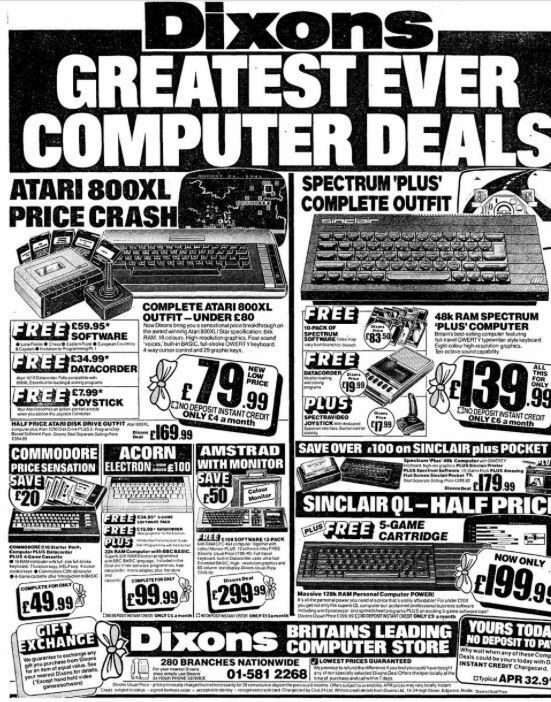
Sinclair justified the price cut with this release;
“The home computer market is currently entering a very vigorous phase and we anticipate strong competition from UK manufacturers in particular. Economies of scale in producing the Spectrum+ – production of which has now reached in excess of 200,000 per month – permit us to take a strong lead in reducing prices in this sector and further increase our market share in the UK beyond its present 44%”
At this time Commodore held 30% and Acorn 10%. But however it was pitched, customers were drying up across the board with 14% of UK households now owning a micro. A figure higher than any other country.
Although the mark had been missed with the QL, another revision of the Spectrum was in order which this time, would be able to capitalise on the masses of software available and bring the machine on a level peg with the Commodore 64 and Amstrad CPC. Paramount to this was improving the basic beeper sound capabilities of the original hardware, perhaps not up to SID standard, but maybe something more similar to the AY chip found in the CPC.
Working alongside Sinclair’s Spanish distributor, Investronica. This machine was a modest revision over the existing hardware, the Spectrum 128. ULA modifications meant the video quality was improved – You may notice on earlier Speccy’s there’s a vertical rolling effect between strongly constrasting colours. This is caused by an interaction between separate oscillators, however the new ULA avoids this by using a single crystal oscillator. Further changes, also allowed an RGB connector to be integrated, offering a crystal clear image compared to the standard RF tuner.
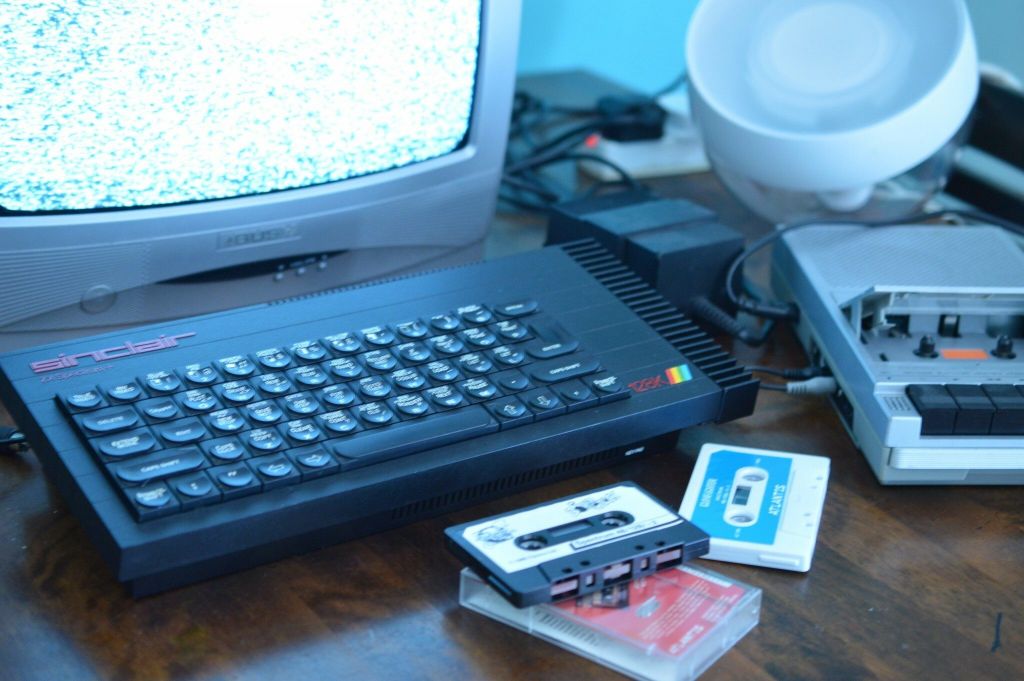
An identical sound chip to the CPC was also integrated, the AY-3-8912A, which goes one up on the CPC, and pushes sound through the television output rather than a tinny on board speaker. Of course the machine also shipped with 128KB of RAM as standard, which as well as offering a nice upgrade, circumvented the tax imposed on machines with less than 65KB of RAM. To accommodate the limitations of the Z80A processor only being able to address up to 64K, Sinclair designers used bank switching so that the new memory would can be accessed through 8 16KB address pages.
The new ROM incorporated 128k BASIC – doing away with shortcut commands, and even featured a rather delightful menu on boot, also offering tape test functionality to ensure your signal strength was setup correctly. It additionally allowed for on screen messages to display in Spanish, another requirement at the time.
Looks wise, the machine is almost identical to the +, with the addition of a whopping heat sink on the right hand side (the slatted appearance paving the way for this particular machine’s nickname, “The Toastrack”). This was to cool the 7805 voltage regulator, and replaced the internal heatsink on earlier models. The lettering is also in red, and for me this machine just looks the absolute nuts. Its the machine my brother and I had in the 80s and I love it to pieces.
The Spectrum 128 was showcased at the SIMO ’85 trade show in Spain during September ’85, with a price of 44,250 pesetas. But due to the number of unsold Spectrum+ models, Sinclair decided not to start selling in the UK until January 1986 at a price of £179.95 – the same as the original + had retailed.
However, this wouldn’t be enough to save Sinclair going forward. Although the company was still profitable going into 1985, consumer outlook of the market coupled with a few misfortunate events, heralded bad news. Firstly Prism Microproducts, Sinclair’s current distributor collapsed into receivership, owing Sinclair over £1M. Secondly, Sinclair had to postpone a stock flotation to raise restructuring funds, due to the adverse sentiment towards the computer sector.
With grim news headlines flying around and the poor sales of the flat screen TV80 and Sinclair C5 quickly catching up – neither of which covered their development costs, Clive was rapidly having to refute allegations that his company was losing £1M per month. Without flotation funds, attitude meant that Sinclair appeared unfavourable to further lending by it’s bank and even if it didn’t have before, by mid 1985 it indeed did have a cash crisis on it’s hands. Sinclair was looking for a rescue bid, which initially came in the form of Robert Maxwell, with a £12M rescue offer and a controlling stake, but Sinclair was able to hang on through negotiation with its bankers and main suppliers.
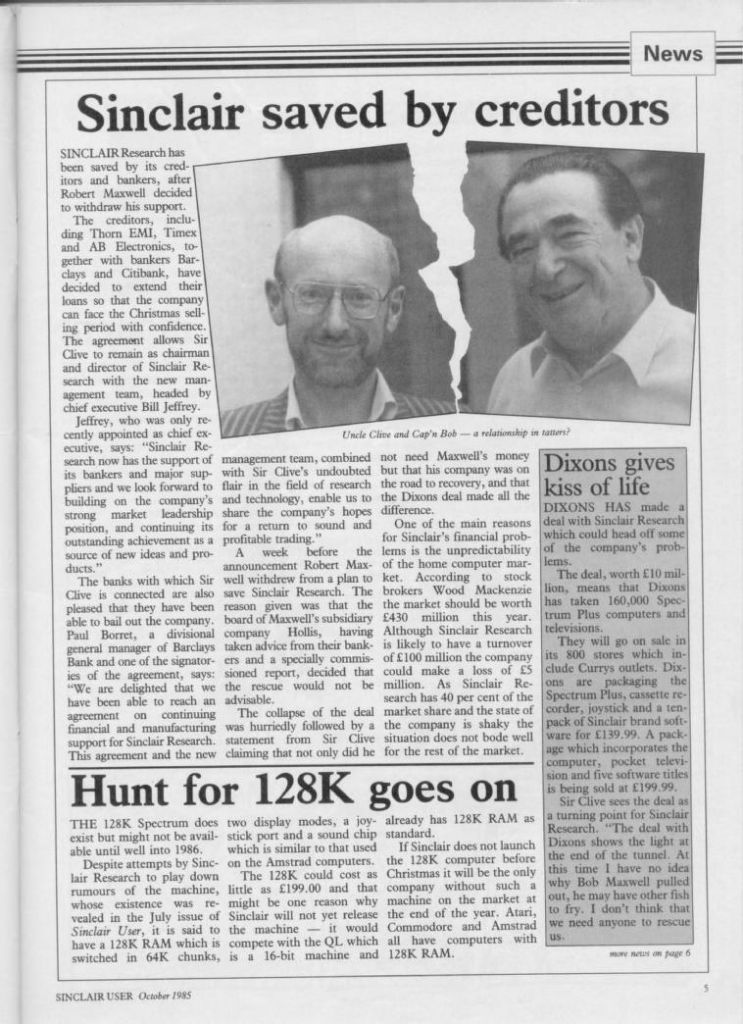
This meant Christmas would come, and the Spectrum 128 would thankfully land in UK shores in January 1986, filling owners with an unprecedented amount of glee, along with some frankly incredible musical renditions on 128k enabled software.
Some had spelled 1985 as the end of home computing, but you and I know that this was never to be the case, as did numerous others who had only just entered the market.
So the real question is… what would come next?
Join me next time for the Amstrad Years….
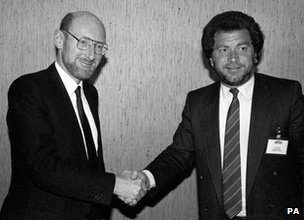

Nostalgia Nerd is also known by the name Peter Leigh. They routinely make YouTube videos and then publish the scripts to those videos here. You can follow Nostalgia Nerd using the social links below.
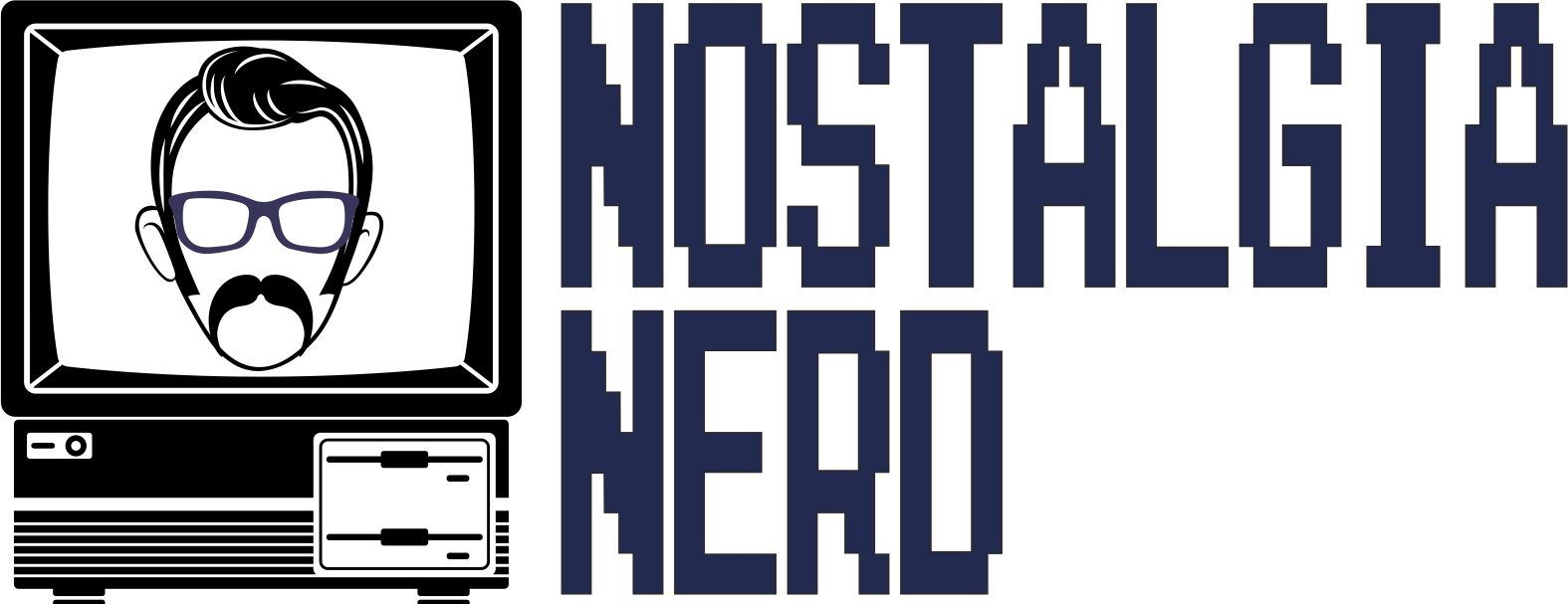
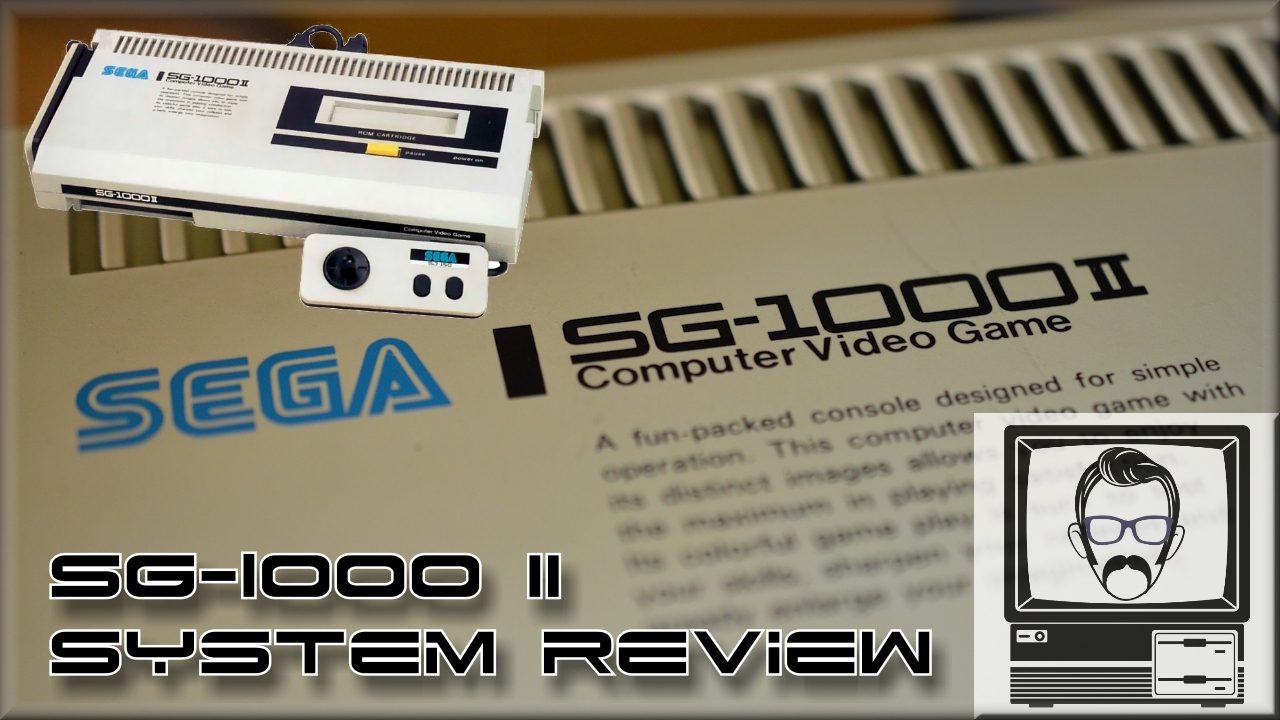
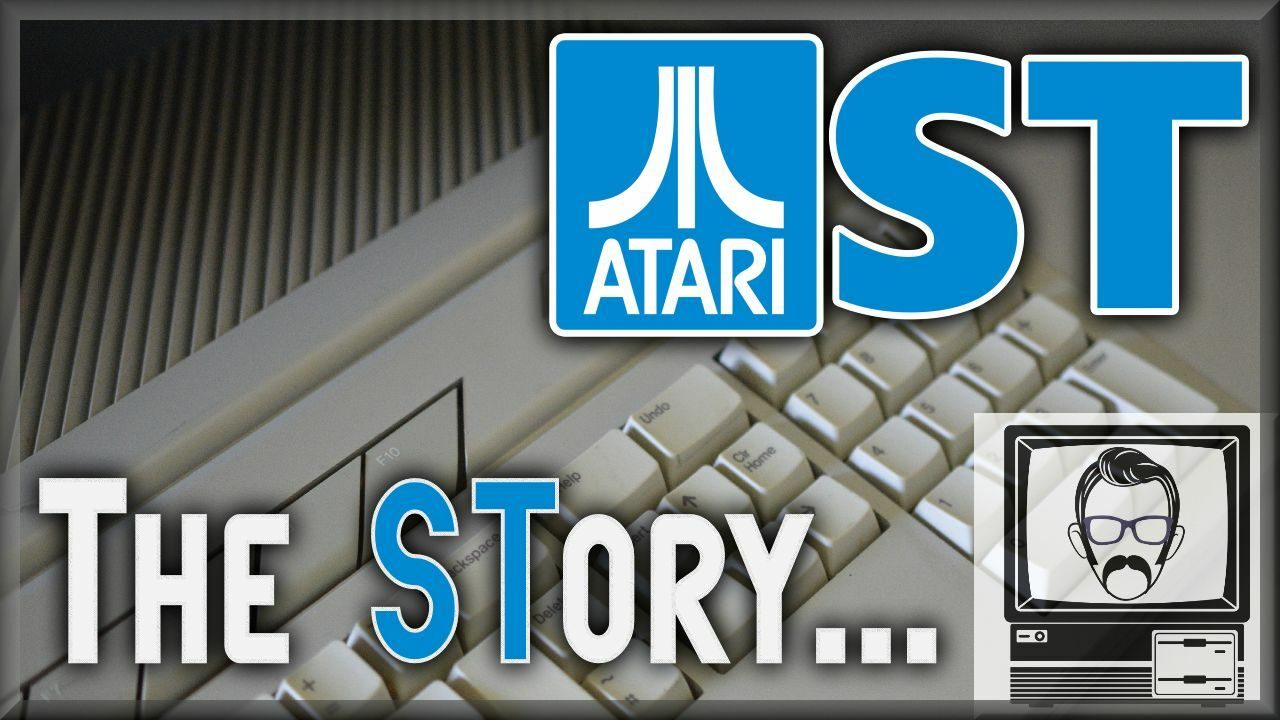
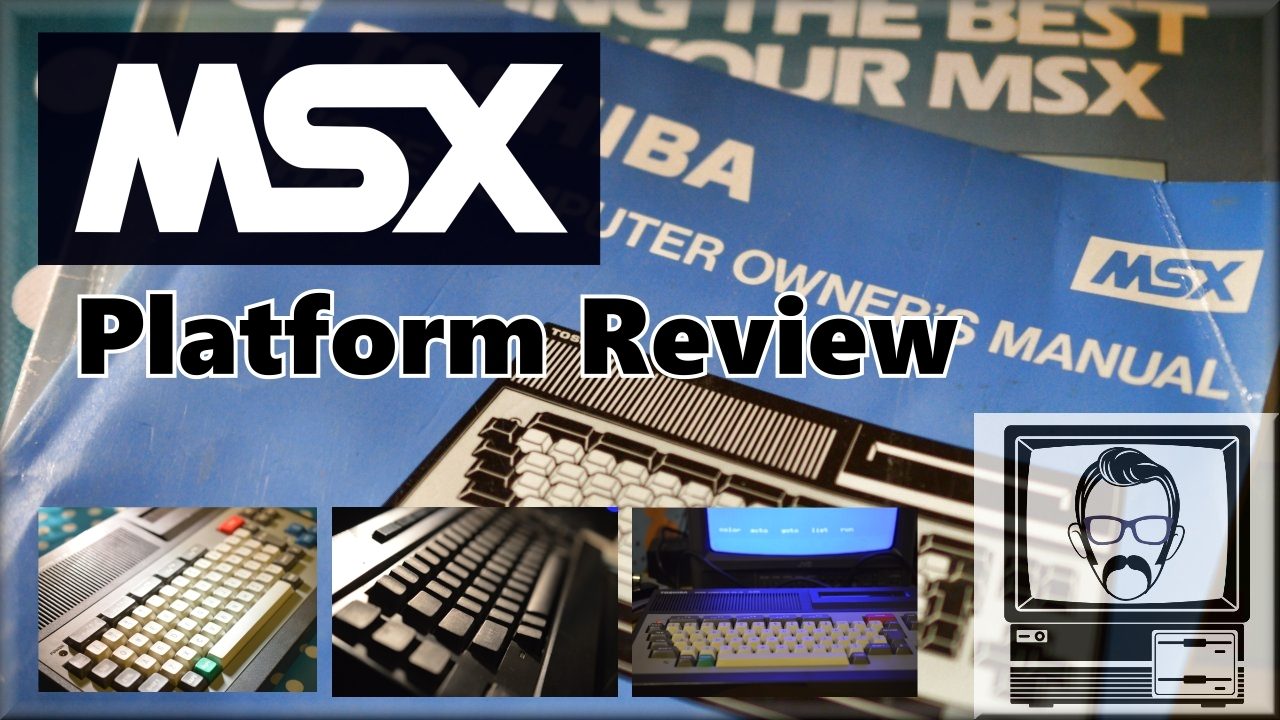
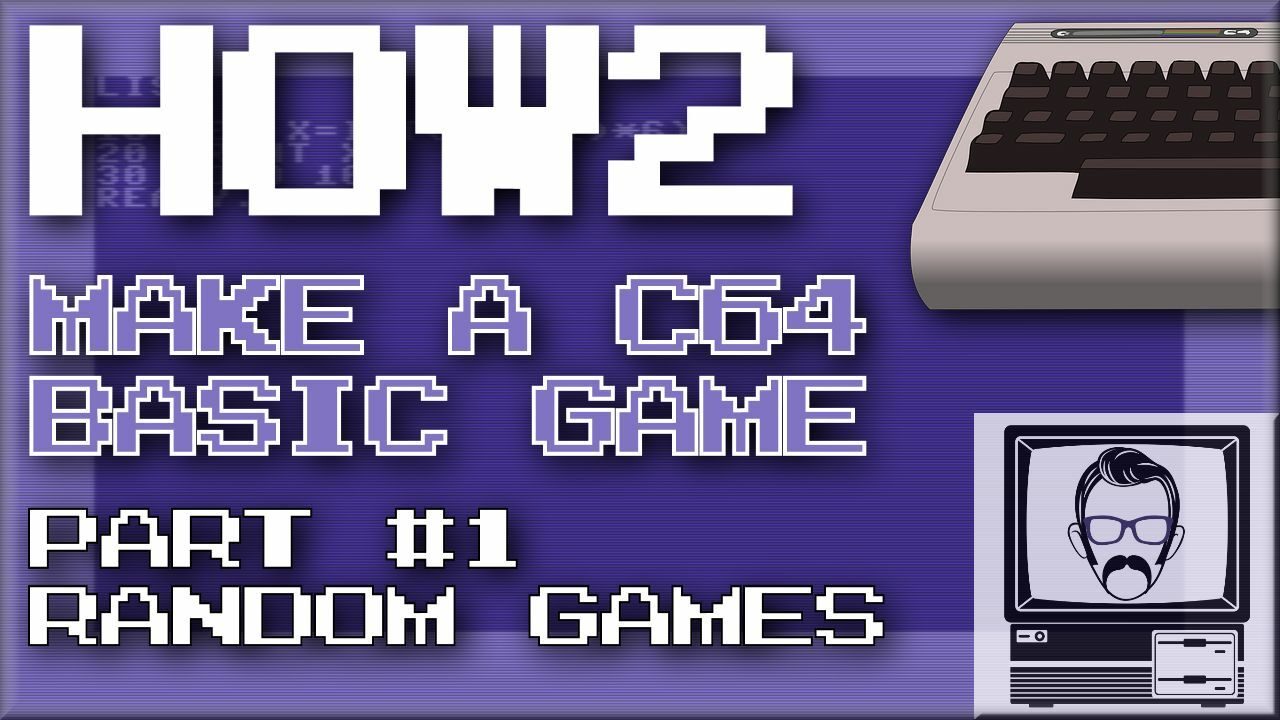
3 Comments
Add Yours →I returned with my grandson to the spectrum. He is enchanting with this computer.
(translated from Polish by google)
3¼mips…eggnchips®€cu™
youtu.be/zsjTpFR0oYQ
I can’t join you next for the Amstrad years there’s no link to klik on help!